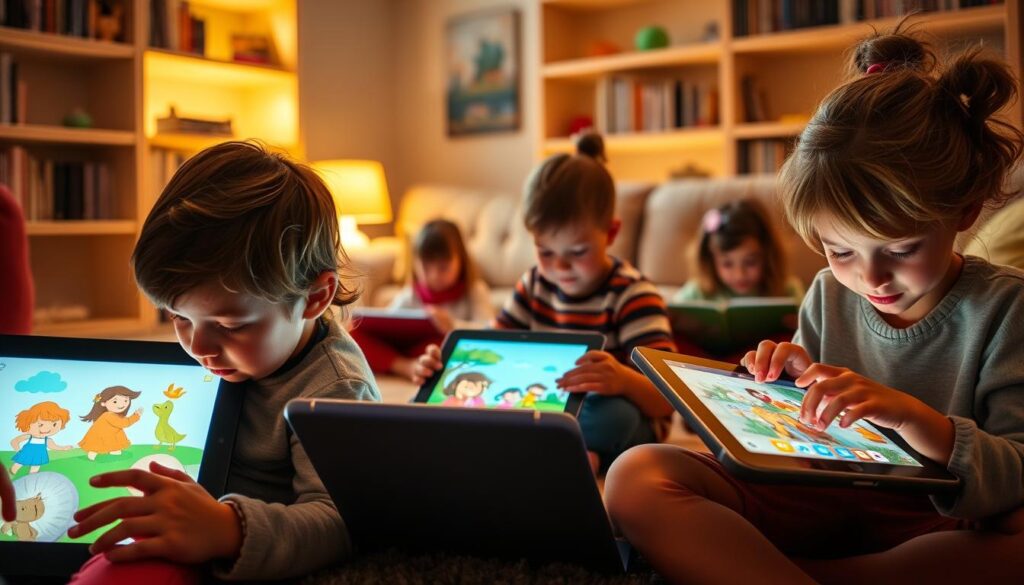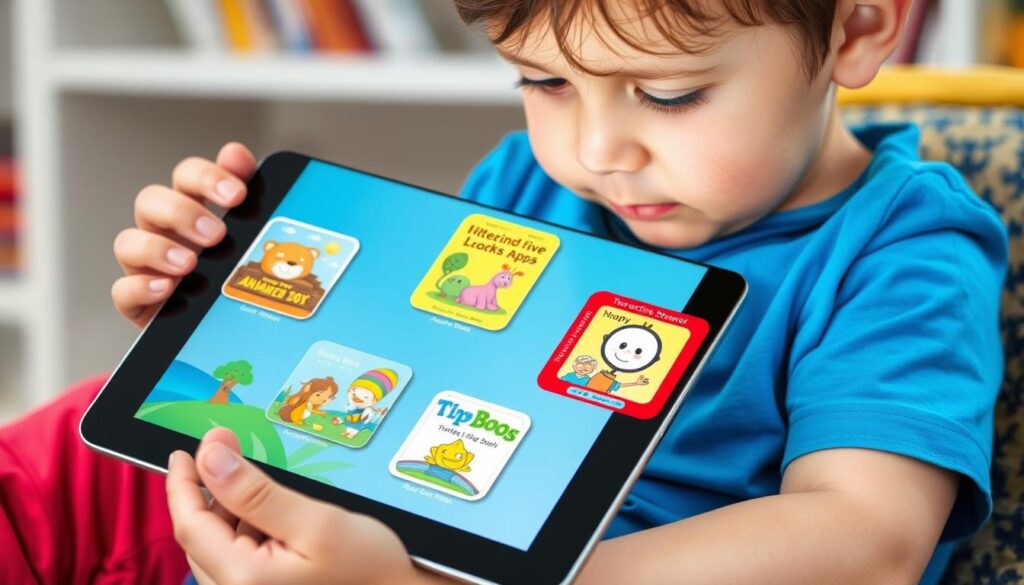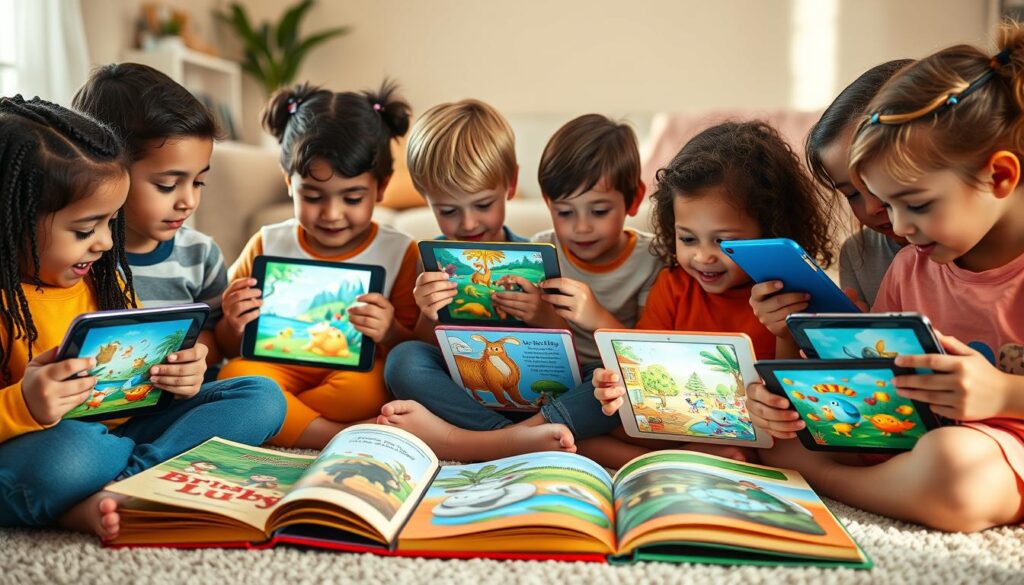Are you wondering if the storytelling apps your child uses are truly making a difference in their learning journey? As a parent, I’ve seen firsthand how digital tools can transform the way kids engage with content and develop crucial skills.
With so many apps available, it’s essential to identify the signs that indicate your child is truly benefiting from these interactive storytelling experiences. In this article, I’ll share the key indicators to look out for, helping you make informed decisions about the digital tools you choose for your child.
By understanding these signs, you’ll be able to recognize when stories come alive, fostering a love for learning that extends beyond the screen.
The Evolution of Digital Storytelling for Children
The way we consume stories has undergone a significant transformation with the advent of digital technology. This shift has been particularly impactful for children, as it has changed the way they interact with narratives and engage with learning materials.
From Traditional Books to Interactive Narratives
Traditional storytelling has given way to interactive digital narratives, offering children a more immersive experience. Educational story apps have become a popular tool for parents and educators, providing a platform that combines entertainment with education. These apps transform the way children consume stories, making it an active rather than passive experience.
How Educational Story Apps Transform Learning Experiences
Educational story apps have fundamentally transformed learning experiences by creating immersive environments where children don’t just consume content – they interact with it meaningfully. These digital tools convert abstract concepts into tangible experiences, making learning more concrete and accessible for young minds. By incorporating interactive features like touch-responsive animations and decision points, these apps give children agency in their learning journey, enhancing their skills and fostering a love for education.
As a result, kids can progress at their own pace, developing essential skills while having fun. This approach to storytelling not only captivates young minds but also lays the foundation for a lifelong love of learning.
Sign #1: Increased Vocabulary and Language Development
One of the most significant indicators that your child is benefiting from educational story apps is the noticeable increase in their vocabulary and language development. As children engage with these interactive storytelling apps, they are exposed to a wide range of new words and phrases that can significantly enhance their communication skills.
New Words and Phrases in Everyday Conversations
When kids regularly use quality educational story apps, you’ll likely notice them incorporating new vocabulary into their everyday conversations. This isn’t just about learning new words; it’s about understanding their context and usage. The interactive stories presented in these apps help children grasp the nuances of language, making their communication more effective.
The interactive elements in these apps prompt verbal engagement, encouraging kids to participate actively in the learning experience. This active participation is crucial for their cognitive development, as they’re not just passively absorbing information but are also shaping their own learning journey.
Improved Pronunciation and Communication Skills
Beyond new vocabulary, you’ll observe significant improvements in your child’s pronunciation and overall communication skills. Many educational story apps feature professional narration that models proper pronunciation, pacing, and expression, giving children an excellent template for their own speech development.
- The read-along features in many storytelling apps highlight words as they’re spoken, creating a powerful connection between written text, visual recognition, and proper pronunciation.
- Interactive dialogue features encourage children to practice speaking clearly and expressively, often recording their own voice and playing it back for self-assessment.
- Parents should watch for increased confidence in communication – children who benefit from these apps often become more willing to express themselves and engage in conversations with adults and peers.
This improvement in communication skills represents one of the most valuable transferable benefits of quality educational story apps, supporting success across all areas of learning and social development for kids.
Sign #2: Enhanced Engagement and Focus During Story Time
Enhanced engagement and focus during story time are key signs that educational story apps are making a positive impact on your child. When children are engaged with storytelling apps, they become active participants in the learning process, navigating through interactive stories that challenge and captivate them.

Active Participation vs. Passive Consumption
The lively nature of digital tales transforms kids into active learners. As they navigate through the twists and turns of these digital adventures, they encounter challenges, dilemmas, and puzzles that require their active participation. This interactive learning environment fosters a deeper connection with the narrative, making the experience more enjoyable and effective.
- A remarkable sign that educational story apps are benefiting your child is their gradually extending attention span during focused activities.
- I’ve observed children who typically struggle to sit through a traditional book suddenly maintaining concentration for 20-30 minutes when engaged with interactive storytelling apps.
Extended Attention Spans Through Interactive Elements
Quality apps strategically incorporate interactive features that recapture attention just as it begins to wane, creating a perfect balance between narrative flow and engagement opportunities. This approach not only enhances their engagement during story time but also contributes to their overall learning experience.
| Benefits | Description |
|---|---|
| Active Participation | Children engage actively with the story, making decisions and solving problems. |
| Extended Attention Span | Kids maintain focus for longer periods, improving their ability to concentrate. |
| Enhanced Learning | The interactive nature of the apps enhances the learning experience, making it more effective. |
Sign #3: Creative Storytelling and Imagination Growth
When children start to weave their own tales, it’s a clear indication that they’re benefiting from the imaginative spark provided by educational story apps. This creative storytelling is a crucial sign of their cognitive and emotional development.
Creating Original Stories Inspired by Digital Content
Educational story apps don’t just entertain; they inspire children to create their own stories. I’ve observed children who regularly engage with quality story apps gradually incorporating more complex elements into their imaginative play. They start developing characters with distinct personalities, motivations, and challenges. This is a significant sign of educational benefit, as it shows growing sophistication in character development and plot construction in their own storytelling attempts.
- Children’s stories evolve from simple sequences of events to more structured narratives with clear problems and resolutions.
- They begin to describe characters’ feelings and thoughts, demonstrating empathy and perspective-taking.
Character Development and Plot Construction Skills
The best educational story apps teach narrative structure implicitly, showing rather than telling children how compelling stories work. As children engage with these apps, they start to internalize these narrative structures, which is evident when they begin planning their stories before telling them. This development of storytelling skills transfers to academic writing as children grow, providing a foundation for essay structure, creative writing, and even scientific reporting.
- Parents should note when children incorporate cause-and-effect relationships into their stories, a sophisticated cognitive skill developed through interactive storytelling.
- The development of these skills is a clear sign that children are benefiting from educational story apps, enhancing their creativity and story creation abilities.
Sign #4: Problem-Solving and Critical Thinking Abilities
As a parent, you might notice that your child’s problem-solving skills are improving with the use of educational story apps. This is because these apps are designed to present children with interactive challenges that foster critical thinking and problem-solving abilities.

Navigating Interactive Challenges Within Apps
Educational story apps offer a range of interactive narratives where characters face various challenges. These challenges become opportunities for children to develop their problem-solving skills. By navigating through these stories, children learn to think critically and make informed decisions. For instance, a story might require a child to help a character solve a puzzle or overcome an obstacle, promoting active learning and critical thinking.
By using these educational tools, children can develop a skill set necessary for life, enhancing their ability to tackle real-world problems.
Applying Story-Based Solutions to Real-Life Situations
One of the most powerful signs that educational story apps are making a difference is when your child begins applying story-based solutions to real-life situations. For example, a child might recall a character from a digital story who overcame a similar obstacle, using that narrative as a template for their own problem-solving. This transfer of learning represents the ultimate goal of educational storytelling – creating mental models that children can access and apply in diverse situations throughout life.
By celebrating these moments, parents can recognize the value of educational story apps in developing their child’s problem-solving skills and critical thinking abilities, preparing them for future challenges.
Sign #5: Your Child is Benefiting from Educational Story Apps Through Digital Literacy

When it comes to educational story apps, one of the most telling signs of their effectiveness is how they help children develop a deeper understanding of digital storytelling. Now, more than ever, storytelling apps are breaking new ground by changing the way young minds communicate through narratives. These creative apps go beyond the usual storytelling by infusing a fine dose of interactivity and engagement, thereby grabbing attention and boosting cognitive development.
Navigating Digital Interfaces with Confidence
As children use educational story apps, they become more confident in navigating digital interfaces. This confidence is a crucial aspect of digital literacy, enabling them to explore and learn from various digital tools and platforms. The best educational story apps are designed to be intuitive, allowing children to easily move through stories and interactive elements, developing their ability to use technology effectively.
Understanding Different Digital Storytelling Formats
Another significant sign of educational benefit is when your child demonstrates an understanding of different digital storytelling formats and their unique characteristics. For instance, they might distinguish between e-books, interactive stories, narrative games, and animated storytelling. You might hear your child making comparisons between formats, such as “This is like a choose-your-own-adventure story” or “This app lets me be part of the story instead of just watching it.” This awareness represents an important aspect of digital literacy, helping children become discerning consumers of media content.
The development of digital literacy through educational story apps is a multifaceted process. It involves not just understanding different formats but also recognizing the purposes and benefits of various digital tools. When children can articulate why they prefer certain digital storytelling formats for particular types of stories, it demonstrates a sophisticated understanding of media that will serve them well in our increasingly digital world.
Sign #6: Social and Emotional Development Through Character Connections
As children engage with educational story apps, one of the most significant benefits they can experience is social and emotional development through character connections. The interpretation of characters and stories becomes a cognitive playground where children can bring their own perspective into the narrative. In these interactive narratives, characters are more than just pixels on a screen; they become a child’s companion on their journey of cognitive exploration.
Empathy Development Through Different Perspectives
Educational story apps can significantly enhance a child’s empathy by exposing them to various characters and their experiences. By navigating through different storylines, children can develop a deeper understanding of different perspectives and emotional responses. This empathetic growth is crucial for building stronger, more meaningful relationships in life. For instance, when children encounter characters facing challenges or making difficult decisions, they learn to consider multiple viewpoints and understand the emotional nuances involved.
Emotional Recognition and Expression Improvement
Another significant sign of benefit is when your child shows improvement in recognizing and expressing their own emotions after engaging with educational story apps. Quality storytelling apps often present characters navigating complex emotional situations, providing children with models for understanding and managing their own feelings. You might hear your child using more specific emotional language, moving beyond basic terms like “happy” or “sad” to more precise descriptions like “frustrated,” “disappointed,” or “proud.” This improved emotional literacy helps children communicate their needs more effectively and resolve conflicts more peacefully, which are essential skills for social success.
The best educational story apps include characters who demonstrate healthy emotional regulation, showing children that all feelings are acceptable while providing strategies for managing intense emotions. When children begin applying emotional regulation strategies from stories in their own lives, such as taking deep breaths when angry or using positive self-talk when nervous, it’s a powerful sign that storytelling is supporting their social-emotional development.
Conclusion: Balancing Digital and Traditional Storytelling for Optimal Benefits
By understanding the impact of educational story apps, we can harness the magic of digital storytelling to foster a love for reading and learning in children. As we’ve explored the six signs that your child is benefiting from these apps, it’s clear that digital storytelling can be a powerful tool in supporting holistic development.
The most effective approach combines the unique benefits of digital storytelling with the irreplaceable value of traditional books and face-to-face storytelling experiences. Establishing a balanced literacy environment where digital story apps complement rather than replace bedtime stories, library visits, and physical books is key.
Quality time spent discussing stories – regardless of their format – remains one of the most valuable ways to enhance the benefits of any storytelling experience. As we look to the future, the distinction between digital and traditional storytelling will likely continue to blur, with the focus shifting to the quality of content and interaction rather than the medium itself.
By remaining attentive to the signs we’ve discussed, you can confidently navigate the evolving landscape of children’s media, ensuring that the stories your child experiences contribute positively to their development as learners, thinkers, and compassionate human beings in a balanced environment that supports literacy and learning.
FAQ
What are some good digital tools for kids to create their own stories?
Some popular options include Book Creator and other interactive storytelling apps that encourage creativity and imagination. These tools allow kids to develop their language skills while having fun.
How do educational story apps improve literacy skills in young minds?
Educational story apps can enhance literacy skills by providing interactive features, such as animations and games, that make learning fun and engaging. This can lead to improved reading skills and a stronger foundation for future academic success.
Can digital storytelling replace traditional reading experiences for kids?
While digital storytelling has many benefits, it’s not necessarily a replacement for traditional reading experiences. A balanced approach that combines both digital and traditional methods can provide the most benefits for kids.
How can parents ensure their kids are using educational story apps effectively?
Parents can monitor their kids’ progress, engage in co-play, and discuss the content with their kids to ensure they’re getting the most out of these tools. This can also help parents identify areas where their kids may need extra support.
What are some signs that my kid is developing critical thinking skills through digital storytelling?
If your kid is able to navigate interactive challenges within apps, apply story-based solutions to real-life situations, and think creatively, it’s likely they’re developing their critical thinking skills.
Can digital storytelling help kids develop emotional intelligence?
Yes, digital storytelling can help kids develop emotional intelligence by exposing them to different characters, perspectives, and experiences. This can help kids develop empathy and better understand their own emotions.




